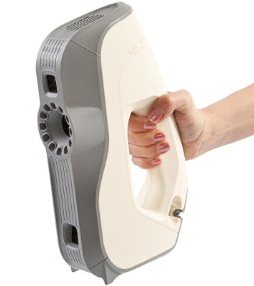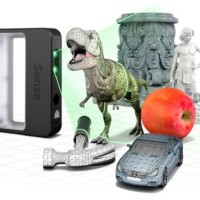Anyone looking to delve into the field of graphics design, engineering/architectural modelling or the field of 3D printing must have either come across the phrases 3D scanners, computer aided design or is sure to come across them as he or she progresses in the chosen design field therefore having some knowledge on what today’s topic covers is key to your success as a designer.
Now, to compare and contrast two very dissimilar design tools that accomplishes similar functions, it is important that some guidelines and parameters are set to make this comparison easy to understand by the reader and also help us meet our goal of providing you with all the information you need when trying to make a choice between both design techniques. Therefore, our criteria for comparison are:
- Design Technique: this criterion covers the tools needed to design or develop 3 dimensional models using both techniques. It will also discuss the design process to be employed when using either a 3D scanner or a CAD software.
- Design Versatility: this criterion discusses the versatility of the techniques and how well equipped each design technique is for designing/developing advanced 3D models as well as their abilities to inspire creativity.
- Ease of Use: the ease of use discusses the learning curve associated with becoming proficient in using any of the discussed design techniques to be covered.
3D Scanners an Overview
 A 3D scanner is a device that analyzes real-world objects, collects its design data—such as; dimensions, shape, appearance, color etc.—and uses the collected data to build a realistic but digital/virtual 3D model of that real-world object.
A 3D scanner is a device that analyzes real-world objects, collects its design data—such as; dimensions, shape, appearance, color etc.—and uses the collected data to build a realistic but digital/virtual 3D model of that real-world object.
The reconstructed virtual 3D model can then be used as a prototype to aid additive manufacturing processes for the scanner provides a very accurate virtual representation of the scanned object. There are a variety of 3D scanning techniques 3D scanners employ to pull this off and some will be discussed and compared with computer aided design.
3D Computer Aided Design an Overview
 Computer aided design is simply the use of computer systems—software, apps, tools—to assist in the creation or modification of an existing design. Which means with CAD, a designer can design an object from scratch as well as introduce an already designed or scanned object into its workspace for modifications.
Computer aided design is simply the use of computer systems—software, apps, tools—to assist in the creation or modification of an existing design. Which means with CAD, a designer can design an object from scratch as well as introduce an already designed or scanned object into its workspace for modifications.
The created or reconstructed virtual 3D model can also be used as a prototype to aid additive manufacturing, the creation of animated movies and game characters or models.
Comparing 3D Scanners and Computer Aided Design
Design Technique: 3D scanners function by scanning a real world object, taking geometrical points from all over the surface of the object, and using these points to reconstruct or extrapolate the shape of the object. While computer aided design techniques employ the use of drafting tools to draw or model a 3D character on the virtual workspace provided by the software. From these definitions; we can make some deductions such as;
- 3D scanners can only be used to reconstruct a digital representation of already manufactured objects while 3D CAD tools can be used to create designs from scratch that have not yet been manufactured
- 3D scanners do not provide the option of editing or modifying its digitally scanned 3D models while CAD tools support edits and can be used for modification projects.
- 3D scanners make use of laser scanners as its design or development tools for picking the necessary features needed to reconstruct an image while CAD makes use of drawing tools, animation and rendering tools to create its 3D models.
Design Versatility: Basically, a 3D scanner is an object reconstruction tool which means the user simply copies an existing design without been provided with the option to be creative. While a 3D CAD software can be used innovatively to create original prototypes of new ideas. Here are some deductions to be made on the versatility of both processes:
- 3D scanners offers no design or creative options whatsoever it copies what it sees while CAD tools enhances creativity.
- 3D scanners do not provided designers with the option of uploading already scanned designs on its work platform while with CAD, virtual designs from 3D scanners, drawings by hands and even camera images in a virtual format can be uploaded and modified on its workspace.
- The model quality a 3D scanner provides is determined by how accurate and advanced the scanner may be. Therefore some scanned images my appear blurry, incomplete or inaccurate if the scanner been used isn’t very advanced while with CAD, the quality of the designed 3D model depends solely on the expertise of the user and less on how advanced the CAD software may be. Designers can also take badly scanned images and fine tune them using the tools provided on the workspace.
Ease of Use: A 3d scanner can be described as a simple machine which once assembled with the right user manual, works directly off the box and this makes it one of the easiest 3D reconstruction tools anyone can use. While the average CAD software is built in such a way that you must put hours into learning the tricks of the trade before your design skills can even be said to be passable and more time must be spent before one can become a professional. So here are the deductions:
- For beginners who already have a real world sample of the object to be designed, the use of a 3D scanner is definitely recommended for no deep knowledge is needed to operate one except when scanning very large objects. While a CAD software could prove to be time consuming if one chooses to design that same object from scratch using the provided tools
- Although scanners are easy to use, they are very limited and cannot be used to execute innovative design ideas while CAD software applications are the perfect tools for innovative design.
3D Scanner VS. 3D CAD in 3D Printing
In conclusion, the choice of any of these 3D design or reconstruction tools generally depends on the model to be designed, the designer’s level of expertise and his or her experience working with either design tool.



Leave a Reply